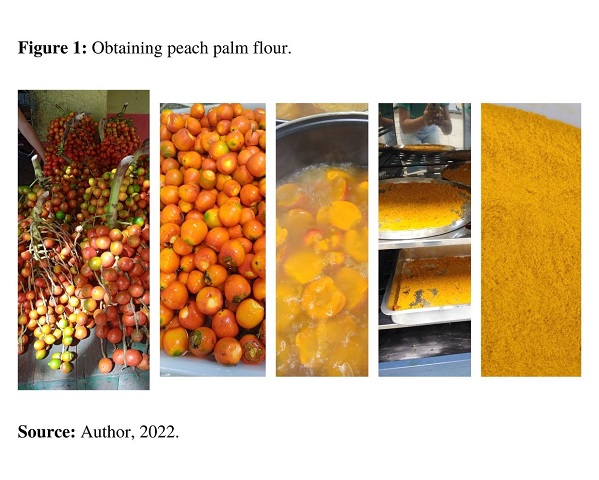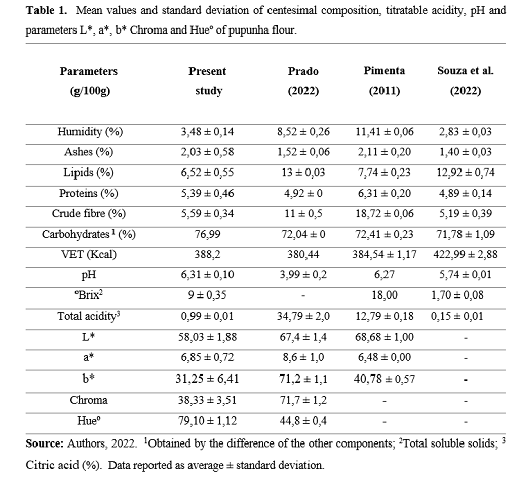Autores
Pereira da Silva Bernardi, D. (UNIVERSIDADE FEDERAL DO TOCANTINS-UFT) ; Freitas Pires, C.R. (UNIVERSIDADE FEDERAL DO TOCANTINS-UFT) ; Souza Pereira, A. (UNIVERSIDADE FEDERAL DO TOCANTINS-UFT) ; Melo Viroli, S.L. (IFTO CAMPUS PARAÍSO DO TOCANTINS) ; Pereira Feitosa, K. (IFTO CAMPUS PARAÍSO DO TOCANTINS)
Resumo
Pupunha is one of the most complete vegetables as food, transforming it into flour
is a way to add value to fresh fruits and diversify their demand. The study aimed
to obtain the whole pupunha flour using the pulp and peel of the fruits and
evaluate the physical-chemical and colorimetric parameters of the obtained flour.
The humidity values were in accordance with the current legislation, which
recommends maximum 15% of moisture in flours. Considerable lipid contents (6.52%),
proteins (5.39%), ash (2.03%), carbohydrates (76.99%) and excellent energy source
388.2 kcal were found. Titratable acidity was (0.99%) and pH (6.31). The results
obtained in the colorimetric parameters showedthat the flour maintained the
characteristic color of the fruit.
Palavras chaves
Amazonian fruits; Flour; Value aggregation
Introdução
The pupunheira (Bactris gasipaes Kunth, Palmae) is a fruit tree native to the
Amazon that presents wide genetic diversity in its wild and domesticated
populations, being found in Central and Northern South America, being, in
Brazil, a plant native to the Amazon region, very common in the states of Pará,
Amazonas, Acre and Amapá (CLEMENT; SANTOS, 2002; OLIVEIRA, 2018). Its fruits are
of high quality, due to its genetic diversity and different nutritional values
of its mesocarp, and can be used in food, human and animal, due to the high
nutritional and energetic value (MELO et al., 2017). In the State of Amazonas,
mainly in the city of Manaus, the greatest economic potential of the pupunheira
is through its fruits, however, every year that passes, it is noted
discouragement on the part of producers to produce fruits of pupunha, due to the
reduction of demand and the fall in price, the fruits are marketed in bunches,
it is common also the sale of fruits cooked in water and salt ready for
consumption (RABELO, 2012) . One of the alternatives for fruit and flour
preparation, being a way to add value to fresh fruits and diversify the demand
for the fruit, avoiding a possible saturation of the market (DIAS; LEONEL, 2006;
CLEMENT et al., 2005). The nutritional composition of the flour is highly
influenced by the genetics of the vegetable, place and type of cultivation, in
addition to the conditions of flour production (SANTOS et al., 2011). With this,
this study aimed to produce a fruit of pupunha flour using its pulp and peel,
following good handling practices, to obtain a high-quality product, and to
evaluate the nutritional composition and the physical-chemical parameters s is
colorimetric.
Material e métodos
The bunches of the fruits of pupunheira were obtained from a rural producer
located in the municipality of Medicilândia, Pará, in February 2022. The fruits
were transported in cardboard box to the Food Technology Laboratory (LATECA) of
the Federal University of Tocantins. The pupunha fruits underwent a pre-
selection following the stages of hygiene and sanitization in hypochlorite
ofsodio to 200 ppm (2 ml of sodium hypochlorite at 10% to 1L of water) for 15
minutes, then were rinsed again in drinking running water for the removal of
excess chlorine. The flour was prepared from the pulpand peel of the fruit s
pupunha, the fruits were cut in half with the aid of stainless steel knife and
removed the seeds, then submitted to thermal processing in boiling water for 30
minutes, after cooking the fruits were grated and dehydrated in a greenhouse
with air circulation at 65ºC (TECNAL, model Te-394/2), aiming to reduce the
moisture content to < 10% (about 48 hours). Subsequently, the dry matter passed
through a knife mill, obtaining a fine flour suitable for use in baking. The
pupunha flour was packed in metallized bags, thus keeping protected against the
incidence of luminosity, until the moment of the analysis. For the
characterization of the flour, the following analyses were performed:
Centesimal omposition, pH, titratable acidity and color, according to the
methodologies described by the Association of Official Analytical Chemist (AOAC,
2012) and Instituto Adolfo Lutz (ITAL, 2005). The color parameters were obtained
through the Minolta Colorimeter equipment and the values of L*, A*, B*, chroma
and Hueº were evaluated, all analyses were performed in triplicates.
Resultado e discussão
All pupunha flours presented in table 1 showed low moisture content, indicating
that drying was adequate according to the legislation. The ash content found in
the present study was higher than those found by Prado (2022) and Souza et al.,
(2022), but very close to that found by Pimenta (2011) of 2.11%. The percentage
of ash usually refers to the inorganic residue composed of minerals. The flour
presented a low lipid content of about 6.52%, this value was lower than that
reported by Prado (2022), with 13% and that of Souza et al., (2022), with
12.92%. The protein content present in pupunha flour in all studies mentioned
above was low, however the values present in the flours can contribute to the
nutritional value of the food to be enriched. For fibers, the value of 5.59%
was found, with a higher value found by Pimenta (2011) 18.72%. A significant
part of pupunha flour is formed by carbohydrates, about 76.99%, this value
corroborates with the other authors. In both studies, a high energy value was
found. The pH presented a value of 6.37, while Prado (2022) obtained 3.99. The
flour has low levels for soluble solids. Acidity is used as a quality standard
because it indicates the state of conservation of the flour. The flour in the
study showed low acidity with 0.99%, while Prado (2022) and Pimenta (2011) found
high levels of acidity 34.79% and 12.79%. The value found for the L* parameter
was 58.03, a value lower than that reported by Pimenta (2011) with 79.22,
showing that the flour obtained is clearer. From the values of parameter, a*
(6,85) and b*(31,25) tracings in the coordinates of chroma parameters and hue
angle the flour color and dark yellow tone, as shown in figure 1.


Conclusões
The results obtained in this study show the potential of using the fruit to obtain
flour, which can be offered outside the fruit harvest, in addition to contributing
to the diversification of the supply of new ones, and also adding value to a fruit
native to the Amazon region, with potential nutritional characteristics. The
results of the analyzes in which the flour was submitted were satisfactory and
corroborate those obtained in other studies, showing some differences, which may
be related to the fruit variety, climate, soil, harvest time and experiment
conditions.
Agradecimentos
We thank CAPS for the financial support through the PDPG-FAP, the Federal
University of Tocantins and the PPG in Food Science and Technology, for the
possibility of carrying out this study.
Referências
CLEMENT, C. R.; SANTOS, L. A. Pupunha in the Manaus market: consumer preferences and their implications. Revista Brasileira de Fruticultura, Jaboticabal, v. 24, n. 3, p. 778-779, 2002. < https://doi.org/10.1590/S0100-29452002000300055 > Access on 13 Julh. 2022.
CLEMENT, C. R; PÉREZ, L. E; VAN LEEUWEN, J. The potential palm trees in Brazil: successes and failures of recent decades. Agrociências, Montevideo, v. 9, n. 1-2, p. 67-71, 2005. Available in: < https://www.embrapa.br/busca-de-publicacoes/-/publicacao/678989/o-potencial-das-palmeiras-tropicais-no-brasil-acertos-e-fracassos-das-ultimas-decadas > Access: 28 Agos. 2022.
DIAS, L.T; LEONEL, M. Physico-Chemical Characterization of Cassava Flours From Different Localities in Brazil. Science and Agrotechnology, Lavras, v. 30, n. 4, p. 692-700, 2006. < https://doi.org/10.1590/S1413-70542006000400015 > Access: 06 Oct. 2022.
OLIVEIRA, S. F. Physicochemical characterization and development of analytical methods for tucumã butter (Astrocaryum aculeatum). 2018. 120 f. Thesis (Master in Pharmaceutical Sciences) - Federal University of Amazonas, Manaus, 2018. < https://tede.ufam.edu.br/handle/tede/6970 > Access at: 25 Junh. 2022.
PRADO, Jenifer Moraes de. Drying parameters for obtaining pupunha flour. 2022, 41 f. Monograph (Bachelor of Food Engineering) - Federal University of Rondônia Foundation, Ariquemes, 2022. < https://ri.unir.br/jspui/handle/123456789/3661> Accessed: 27 Aug. 2022.
PIMENTA, L. B. Technological, physical and chemical properties of pupunha flour (Bactris gasipaes). 2011. 98 f. Thesis (Master in Food Science and Technology) - Federal University of Pará, Belém, 2011. https://www.ppgcta.propesp.ufpa.br/ARQUIVOS/dissertacoes/2011/Lidiane%20Pimenta.pdf Acesso on 09 Mar. 2022.
RABELO, AFONSO. Native fruits of the Amazon: marketed at the fairs of Manaus- AM: Native fruits. 1. Ed. Rev. Manaus - AM: INPA PUBLISHING HOUSE, 2012. 390 p. v. ISBN 978-85-211-0073-7. E-book(390p.) Available in:< https://repositorio.inpa.gov.br/handle/1/4706>. Access: 14 Mar. 2022.
SANTOS, R. P.; CRISTO-ARAÚJO, M., PICANÇOTODRIGUES, D., ASTOLFI FILHO, S., CLEMENT, C. R. (2011). Genetic variability and gene flow in hybrid and wild pupunha populations accessed with RAPD markers. Revista Brasileira de Fruticultura, 33 (4): <1200-1208. https://doi.org/10.1590/S0100-29452011000400019 > Accessed: 05 Feb. 2022.
SOUZA, PG de; PANTOJA, L.; SANTOS, AS dos.; MARINE, HA; SILVA, JBA and. Physical-chemical evaluation of pupunheira flour (Bactris gasipaes Kunth) for food use. Revista Brasileira de Ciências , [S. l.] , v. 1, n. 2, p. 65-74, 2022. DOI: 10.14295/bjs.v1i2.37. Available in: <https://brazilianjournalofscience.com.br/revista/article/view/37 >. Access: 9 Sep. 2022.
TOMAS MELO, C. M.; COSTA, L.L.; PEREIRA, F.C.; CASTRO, L. M. de; NEPUMOCENO, S. Physicochemical analyses of the "in natura" fruit of the pupunha. Inova Science & Technology Magazine / Innovative Science & Technology Journal, [S. l.] , v. 3, n. 1, p. 13–17, 2017. Available in: < https://periodicos.iftm.edu.br/index.php/inova/article/view/256 > Access: 6 Sep. 2022.
















